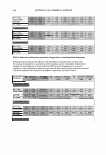322 JOURNAL OF COSMETIC SCIENCE cleanser, with scores of 3.025 ± 0.12, 2.783 ± 0.141, 1.8 ± 0.25, 3.4 ± 0.11, and 2.34 ± 0.25, respectively (Figure 3). DISTRIBUTION OF FLUORESCEIN STAINING The maximum area and density scores at each examining timepoint for the fluorescein staining patterns of each ocular tissue were multiplied and totaled for all examination intervals. Scores from each evaluated tissue were weighted, based on a modification of the Draize method (5,6) for assessing ocular irritancy potential, and totaled to determine an overall fluorescein staining score for all eyes by the following equation: Total weighted score = (palpebral + bulbar) x 2 + cornea x 5 + caruncle x 1. The distributions of the average weighted score (Figure 4) for liquid makeup, shampoo, baby wash, eye makeup remover, mascara, powder eye shadow and facial cleanser were 11.4 ± 1.34, 31.03 ± 1.52, 39.19 ± 2.70, 9.6 ± 0.91, 39.92 ± 3.45 and 9.55 ± 1.98, respectively. The scores for shampoo, baby wash, and powder eye shadow were statistically signifi cantly higher than those of the others (p 0.05). POST-INSTILLATION EVALUATION INTERVALS The Draize method and the modified Draize methods, such as the FHSA method, the OECD method, and the FIFRA/TSCA method (7 ,8), established the stipulated intervals for observing irritation, which were limited to 1, 24, 48, and 72 hours after adminis tration of the test material in animals. Human eyes are highly sensitive to cosmetic products and respond frequently and quickly to test material exposure. Therefore oph thalmic evaluations were performed at the following time intervals: 30 seconds, 5 minutes, 15 minutes, 60 minutes, 120 minutes, and 24 hours post-instillation. Sub- 4.5 4 3.5 (I) : 3 � 2.5 "' 2 a, 1.5 0.5 0 Liquid makeup Sha"l)OO Baby wash Eye makeup remowr Mascara PO'Ader eye Facial cleanser shadow Figure 3. Average maximum levels of objective irritation.
50 45 CIJ "i 40 .J 35 � 30 ,! 25 � a, � 20 CD a, 15 CD � 10 5 0 Liquid makeup ASSESSMENT OF OCULAR IRRITANCY 323 Shampoo Baby wash Eye makeup remover Mascara Po'A{:ler eye Facial cleanser shadow Figure 4. The distribution of weighted scores of area and density of fluorescein staining patterns. jective reports of irritation and objective ophthalmic scores, as well as fluorescein stain ing patterns, were observed during the post-instillation examinations. The average subjective irritation scores for all product types peaked at 30 seconds post-instillation and decreased markedly at the 5 minute examination, with the exception of powder eye shadow, which decreased at 15 minutes post-instillation (Figure SA). Objective oph thalmic irritation was observed in various patterns (Figure SB). Objective irritations decreased at the 5 minute examination for liquid makeup, mascara, eye makeup remover, and powder eye shadow, and at the 60 minute examination for shampoo and baby wash. However, objective irritation for facial cleanser persisted at 120 minutes following ocular instillation. The average weighted scores (Figure SC) of fluorescein ophthalmic staining of ocular tissues revealed that superficial punctate staining peaked at 15 min utes post-instillation for shampoo, baby wash, eye makeup remover, mascara, and pow der eye shadow, and at 60 minutes post-instillation for liquid makeup and facial cleanser. Most ocular irritation resolved after 24 hours. The statistical analysis of weighted scores for fluorescein staining at post-instillation examination intervals dem onstrated a very good correlation (r 0.95) between facial cleanser, shampoo, or powder eye shadow and baby wash, and a fair correlation (r 0.75) between powder eye shadow or facial cleanser and mascara (Table III). CONCLUSIONS Based on the comparison analysis of the limited data in each product category, this study has demonstrated that subjective irritation reports, objective ocular irritation, and fluo rescein staining patterns attenuated rapidly during the two-hour study period for all categories except facial cleanser. Mascara and powder eye shadow elicited more subjective ocular discomfort shampoo and baby wash exhibited higher objective ocular irritation scores and shampoo, baby wash, and powder eye shadow elicited greater ocular tissue
Purchased for the exclusive use of nofirst nolast (unknown) From: SCC Media Library & Resource Center (library.scconline.org)






































































































